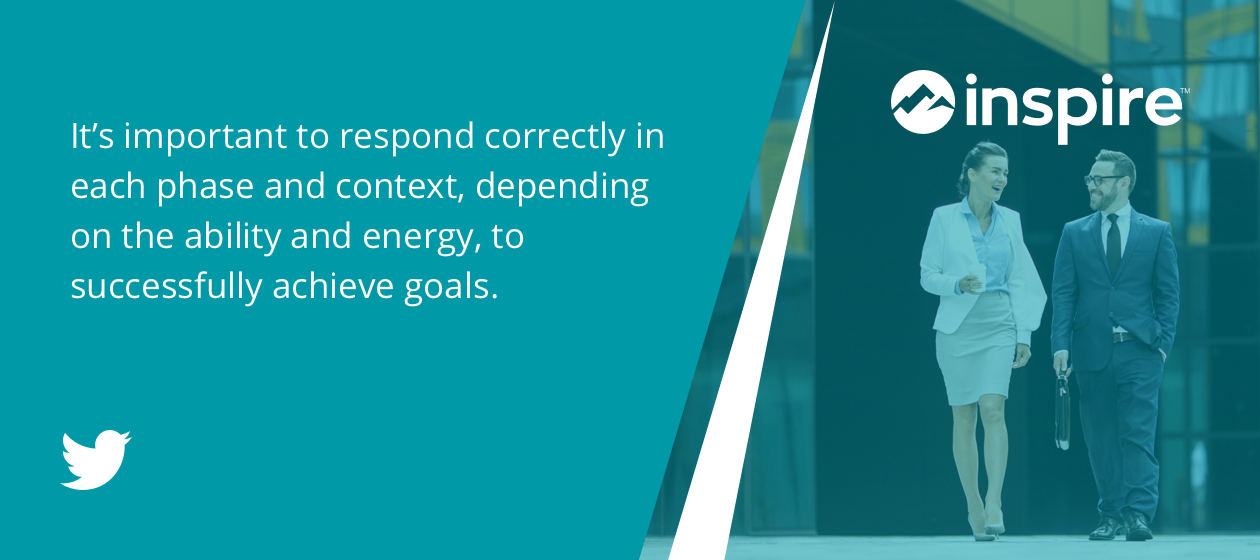Ongoing Feedback and Recognition
It’s a new year with new goals for you, your team, and your organization. But that doesn’t mean that you should wait until the end of the year to check back in with those goals. In fact, ongoing feedback and recognition conversations about the progress, challenges, and triumphs of you and your team goals are critical to, not only the achievement of those goals but improving engagement and optimally motivating others toward the common objectives you’re striving for.
How we manage performance is changing. In the past decade, human capital management has experienced major shifts from a traditional annual review of performance, to quarterly reviews, and more recently, an agile (weekly or bi-weekly) approach of continual performance assessments throughout an organization. Some organizations have made performance evaluations extinct.
A #leader is anyone who can focus and inspire you. Check out this article from @InspireSoftware and learn how being an influential leader helps you respond correctly in each phase and context: Tweet This!Performance is a Verb
Most approaches to performance management are too broad and general to make a real impact of optimizing the performance of an individual, team, or organization toward a common objective or key activities related to the objective. Not only are performance appraisals, regardless of cadence, a big time consumer, they are often a sub-optimally motivating process when it comes to understanding the importance of the work we do. Performance isn’t some person, place, or thing, it’s an active moving body of ideas and move toward an objective. Performance, like leadership, is a verb! And therefore, there is no one general way to respond or recognize performance while it’s happening, and even more difficult to evaluate after it’s happened, even if you’re only looking at the financial outcomes of performance.
How you give feedback and recognize achievements, is even more important than the frequency of the feedback and recognition you give. Performance conversations need to happen in the context of the flow of an individual, team, or organization’s performance. These conversations need to consider the skills and psychological needs of the individuals or groups of individuals pursuing the objective and require the intentional use of skills to effectively influence them.
Common Performance Conversations
With the move to more frequent performance conversations, it’s more critical than ever to have a unified language and approach on how you respond to performance throughout the organization. Continual performance conversations could backfire if an organization when it is not unified and transparent on how they manage and evaluate performance.
If a manager in one part of the organization has a proven leadership method that produces high engagement and desired business outcomes through their performance conversations, but another leader in a different unit of the company uses a different method, it may cause confusion when collaborating across the organization. If some managers are not using any defined leadership methods, or are simply disengaged in the best practices of performance management, it could erode trust and produce negative engagement perceptions about fairness and efficiency throughout the entire organization.
Responding to Performance
In his book, Achieving Leadership Genius, Dr. Drea Zigarmi explains that one of the most critical practices of leadership, in any context, is how you effectively respond to performance. Keeping in mind, that a leader is not just an executive, manager, or team leader within an organization, but can be anyone who can focus and inspire you during the pursuit of individual or collaborative objectives. Keeping individuals, teams, and organizations engaged in the pursuit of key objectives is no longer a nice to have the initiative to market your organization as a “Best Place to Work,” but more importantly a vital business strategy to develop human capital as a viable means to producing a healthy economic outcome for the organization.
While the leadership practice of responding to performance is rooted in generations of organizational psychology and some of the most recognized leadership theories, the practice of responding to performance has never been more relevant and important than in the context of continual performance conversations.
The respond practice is all about being able to answer questions and respond to needs. Read more from @InspireSoftware on the respond practice of #leadership and be on your way to successfully achieve your goals: Tweet this!Responding to performance is all about being able to quickly and effectively assess individual, team, or organizational performance toward key objectives. Great leaders are aware of the strengths, weaknesses, skills and motivations of their people at any given time during the performance process. And since performance is a verb, those needs are in constant flux, requiring aligned leadership skills and behaviors that meet the situational needs of the people pursuing those goals.
Two Key Leadership Behaviors for Responding to Continual Performance
So, how do you know what leadership response is appropriate when there are so many ways you could potentially respond to your performance or the performance of others? The Leadership Genius approach to performance begins by assessing two major skill sets, the Ability and the Energy of an individual, team, or organization during the pursuit of a goal. These two factors reveal five phases of performance that require their own unique responses based on the levels of skills and motivation toward the key objective.
Once you’ve assessed the phase of performance of an individual (see The Two Most Critical Factors for Assessing Continual Performance) a leader needs to respond effectively to the phase of performance the individual, team, or organization is in. The Leadership Genius approach to performance defines the two most effective styles of response to performance are Focusing and Inspiring leadership behaviors.
Responding to Phases of Performance
 It’s important to understand the ebbs and flows of ability and energy when individuals, teams, and organizations experience during the pursuit of their objectives. Great leaders, in any context of leadership, are aware of these ebbs and flows and are ready to respond with effective feedback and recognition based on the just-in-time performance needs of individuals and teams.
It’s important to understand the ebbs and flows of ability and energy when individuals, teams, and organizations experience during the pursuit of their objectives. Great leaders, in any context of leadership, are aware of these ebbs and flows and are ready to respond with effective feedback and recognition based on the just-in-time performance needs of individuals and teams.
When performance is in the early phases of goal pursuit, leaders often need to use skills that help individuals Focus on what matters most in the pursuit of the objective. In the early phases of performance, leaders need to build good goal setting and OKR writing skills in order to set people up for good performance long term. They explore roles and strengths and ensure they are aligned to the objective they are pursuing. While effective feedback is critical during any phase of performance, it is most critical during the early phases of pursuing a goal.
When individuals and teams begin to demonstrate a growth in skills and competence toward the goal, the commitment and motivation toward the objective naturally increases. As goals reach the more advanced phases of performance, leaders need to continually assess and nurture the energy of the individuals and teams pursuing the objective through more Inspiring styles of leadership.
Great leaders, in the advanced phases of performance toward an objective, listen to the ideas and solutions of the individual team members, serving more as a coach and mentor as the individual or team gets closer to achieving the goal. They facilitate problem-solving activities that continue to threaten the desired outcomes of the goal. They also recognize the efforts and success of individuals and teams in a way that is optimally motivating to them. If energy dips for any reason, it’s important that the feedback and recognition of these realities shift the nature of the ongoing conversations toward a goal.
Summary
While considering the benefits of a modern approach to performance feedback, keep in mind the body of knowledge and wisdom found in the research of effective leadership development practices. Responding to the real-time needs of an individual’s, team’s, and organization’s performance, is one of the most important leadership practices, regardless of your approach to managing and analyzing performance.
Don’t just give feedback on performance without understanding the physical and psychological needs of the people you’re attempting to influence. Responding to the energies and abilities of your people is critical to being able to effectively and continually focus and inspire them for optimal performance.
Want to read more about respond or the other four practices of leadership? Explore this and more in Dr. Drea Zigarmi’s book, Achieve Leadership Genius.
Learn more about the 5 contexts of leadership discussed in this article:
- 5 Effective Leadership Contexts to Help Your Organization
- The One-to-One Context: Your Role in Developing Individual Excellence
- The Team Context: Your Role in Facilitating High-Impact Teams
- The Organizational Context: Your Role in Generating the Organization's Vitality
- The Alliance Context: Your Role in Strategic Networking


.png?width=1260&name=INSP-The-Respond-Practice-Blog-Insert-2%20(1).png)
